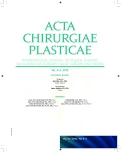A-06 COMPARISON OF ERYTHROCYTE, LEUKOCYTE AND PROGENITOR CELLS COUNT IN LIPOASPIRATE COLLECTED USING VARIOUS LIPOSUCTION TECHNIQUES
Authors:
I. Justan 1; E. Trupar 2; J. Skopalík 3
Authors‘ workplace:
Surgal Clinic, Department of Plastic and Aesthetic Surgery, Brno, Czech Republic
1; Burn Unit, University Hospital Brno, Brno, Czech Republic
2; Center of Biomedical Engineering - International Clinical Research Center, St. Anne University Hospital Brno, Czech Republic
3
Published in:
ACTA CHIRURGIAE PLASTICAE, 57, 3-4, 2015, pp. 54-55
Category:
Selected abstracts from the 36th national congress of the czech society plastic surgery with international participation
Introduction
Lipografting has recently become a relatively common technique. Our team has performed a pilot project in the year 2012 with aesthetic augmentation of the breasts, during which was administered fat enriched with autologous cells with stromal vascular fraction (SVF). Cells in SVF are usually obtained for aesthetic procedures by filtration of a part of collected lipoaspirate and then they are used to enrich the lipoaspirate intended for autologous application. Isolated concentrated cell mixture of SVF consists of pre-adipocytes, fibroblasts, endothelial cells, pericytes and precursors of mesenchymal stromal cells (MSC). According to various studies, these precursors of MSC cells play an important role in long term take of fatty tissue and its subsequent growth. Their number and viability in collected lipoaspirate and in isolated SVF is therefore one of the important parameters. The study analyzes the yield and vitality of SVF (or MSC cells) and also the yield and vitality of adipocytes in lipoaspirates harvested with various manual and machine harvesting methods.
Methods
Lipoaspirate was harvested in totally 8 volunteers. There were the following techniques used for harvesting of lipoaspirate: 1) manual technique according to Coleman using 10 ml syringes, 2) suction using piston suction device Medela Dominant 50® with high vacuum -90kPa (i.e. -675 mmHg), with moderate vacuum around -60 kPa (i.e. -450 mmHg) and with low vacuum -30 kPa (i.e. -225 mmHg), 3) Microair PAL 650 System Liposculptor® – vibration liposuction device with vibration mode 4000/minute and with reduced vibration mode 2800/minute, 4) rotation oscillation liposuction of the Swiss company Bien-Air® with frequency of oscillation 2000/minute and 5) Body-jet® device, the harvesting cannula of which features a water microjet. Cannulas used for harvesting had a diameter of 3 mm and 4 mm and they were part of the equipment of the individual manufacturer’s device. Manual suctioning was performed using the cannula from the company Microair after switching off vibration. Harvested samples of lipoaspirate (harvested in the same area in one patient using different methods) were compared from the point of cell yield, viability of adipocytes, yield of SVF, admixture of red cells and long term viability of MSC cells. For the isolation of SVF from lipoaspirate was used the method of enzymatic tissue release. After 24 and 7 days was microscopically quantified the number of adherent MSCs.
Results
The diameter of the cannula, vacuum level and intensity of vibration mode have an effect on the content of viable SVF cells and amount of harvested MSCs. The number of SVF cells for each method was within a wide range of 11 to 22 x 106 (isolation from 5 ml of lipoaspirate). The greatest yield of SVF from the aforementioned methods 1) to 4) was achieved with the use of 3 mm cannula with adjusted maximal vacuum and reduced vibration (22 ± 3 x 10 3 from 5 ml of lipoaspirate). The yield of viable MSC cells was however higher for 4 mm cannula during reduced intensity of vibrations and vacuum (79 ± 18 from 5 ml of lipoaspirate after 24 hour adherence). High vacuum level increases admixture of erythrocytes during isolation of SVF fraction (up to 900 x 103erythrocytes during isolation from 5 ml of lipoaspirate), which is probably related with the damage of capillaries. High vacuum pressure also reduces the number of intact and viable adipocytes. The technique v) was compared with other harvesting techniques on a special group of samples, and showed higher yield of SVF and viable MSCs (650 ± 90 adherent cells in 5 ml of fat), but not intact adipocytes.
Conclusion
The result of our study shows that it is not simple to find a single method for harvesting good quality lipoaspirate, which would also contain a maximal amount of intact viable adipocytes and viable MSCs. It seems that more gentle harvesting methods with low vacuum are ideal for harvesting the best quality adipocyte fraction in lipoaspirate. Cannulas with greater diameter, using vibrations and high vacuum showed increased amount of erythrocyte admixture. The harvesting technique using water jet shows low damage of microvessels, which is especially suitable for effective isolation of SVF.
Labels
Plastic surgery Orthopaedics Burns medicine TraumatologyArticle was published in
Acta chirurgiae plasticae

2015 Issue 3-4
Most read in this issue
- 36th NATIONAL CONGRESS OF THE CZECH SOCIETY OF PLASTIC SURGERY WITH INTERNATIONAL PARTICIPATION
- Dorsoradial forearm flap with silicone bone spacer in reconstruction of A combined THUMB injury – case report
-
ZORA JANŽEKOVIČ
(September 30, 1918 – March 17, 2015) - Editorial
